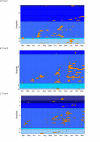Linking healthcare associated norovirus outbreaks: a molecular epidemiologic method for investigating transmission
- PMID: 16834774
- PMCID: PMC1539008
- DOI: 10.1186/1471-2334-6-108
Linking healthcare associated norovirus outbreaks: a molecular epidemiologic method for investigating transmission
Abstract
Background: Noroviruses are highly infectious pathogens that cause gastroenteritis in the community and in semi-closed institutions such as hospitals. During outbreaks, multiple units within a hospital are often affected, and a major question for control programs is: are the affected units part of the same outbreak or are they unrelated transmission events? In practice, investigators often assume a transmission link based on epidemiological observations, rather than a systematic approach to tracing transmission.Here, we present a combined molecular and statistical method for assessing:1) whether observed clusters provide evidence of local transmission and2) the probability that anecdotally|linked outbreaks truly shared a transmission event.
Methods: 76 healthcare associated outbreaks were observed in an active and prospective surveillance scheme of 15 hospitals in the county of Avon, England from April 2002 to March 2003. Viral RNA from 64 out of 76 specimens from distinct outbreaks was amplified by reverse transcription-PCR and was sequenced in the polymerase (ORF 1) and capsid (ORF 2) regions. The genetic diversity, at the nucleotide level, was analysed in relation to the epidemiological patterns.
Results: Two out of four genetic and epidemiological clusters of outbreaks were unlikely to have occurred by chance alone, thus suggesting local transmission. There was anecdotal epidemiological evidence of a transmission link among 5 outbreaks pairs. By combining this epidemiological observation with viral sequence data, the evidence of a link remained convincing in 3 of these pairs. These results are sensitive to prior beliefs of the strength of epidemiological evidence especially when the outbreak strains are common in the background population.
Conclusion: The evidence suggests that transmission between hospitals units does occur. Using the proposed criteria, certain hypothesized transmission links between outbreaks were supported while others were refuted. The combined molecular/epidemiologic approach presented here could be applied to other viral populations and potentially to other pathogens for a more thorough view of transmission.
Figures



Similar articles
-
Outbreaks of gastroenteritis due to infections with Norovirus in Switzerland, 2001-2003.Epidemiol Infect. 2005 Jun;133(3):429-37. doi: 10.1017/s0950268804003619. Epidemiol Infect. 2005. PMID: 15962549 Free PMC article.
-
Hospital outbreak of gastroenteritis due to Norovirus in Belgium.Acta Clin Belg. 2004 Jan-Feb;59(1):30-3. doi: 10.1179/acb.2004.005. Acta Clin Belg. 2004. PMID: 15065694
-
Molecular and epidemiological features of gastroenteritis outbreaks involving genogroup I norovirus in Victoria, Australia, 2002-2010.J Med Virol. 2012 Sep;84(9):1437-48. doi: 10.1002/jmv.23342. J Med Virol. 2012. PMID: 22825823
-
[Epidemic and control strategy on nosocomial outbreak of norovirus gastroenteritis].Zhongguo Yi Xue Ke Xue Yuan Xue Bao. 2008 Oct;30(5):614-7. Zhongguo Yi Xue Ke Xue Yuan Xue Bao. 2008. PMID: 19024398 Review. Chinese.
-
Noroviruses: agents in outbreaks of acute gastroenteritis.Disaster Manag Response. 2004 Jan-Mar;2(1):4-9. doi: 10.1016/j.dmr.2003.11.001. Disaster Manag Response. 2004. PMID: 14760287 Review.
Cited by
-
Loop-mediated isothermal amplification (LAMP): a rapid, accurate, and cost-effective diagnostic method for infectious diseases.J Infect Chemother. 2009 Apr;15(2):62-9. doi: 10.1007/s10156-009-0669-9. Epub 2009 Apr 25. J Infect Chemother. 2009. PMID: 19396514 Free PMC article. Review.
-
Emergence of new norovirus variants on spring cruise ships and prediction of winter epidemics.Emerg Infect Dis. 2008 Feb;14(2):238-43. doi: 10.3201/eid1402.061567. Emerg Infect Dis. 2008. PMID: 18258116 Free PMC article.
-
An integrated approach to identifying international foodborne norovirus outbreaks.Emerg Infect Dis. 2011 Mar;17(3):412-8. doi: 10.3201/eid1703.100979. Emerg Infect Dis. 2011. PMID: 21392431 Free PMC article.
-
An outbreak of norovirus gastroenteritis in an Austrian hospital, winter 2006-2007.Wien Klin Wochenschr. 2009;121(3-4):137-43. doi: 10.1007/s00508-008-1135-x. Wien Klin Wochenschr. 2009. PMID: 19280140
-
Electronic outbreak surveillance in Germany: a first evaluation for nosocomial norovirus outbreaks.PLoS One. 2011 Mar 8;6(3):e17341. doi: 10.1371/journal.pone.0017341. PLoS One. 2011. PMID: 21408157 Free PMC article.
References
-
- Wheeler JG, Sethi D, Cowden JM, Wall PG, Rodrigues LC, Tompkins DS, Hudson MJ, Roderick PJ. Study of infectious intestinal disease in England: rates in the community, presenting to general practice, and reported to national surveillance. The Infectious Intestinal Disease Study Executive. Bmj. 1999;318:1046–1050. - PMC - PubMed
Publication types
MeSH terms
LinkOut - more resources
Full Text Sources
Medical
Molecular Biology Databases
Miscellaneous

